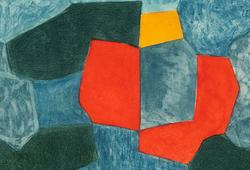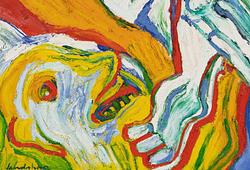Carl Fredrik Hill
Landscape with exotic animals.
Numbered 4 and inscribed on the reverse. Colour chalk on paper 21.5 x 34.5 cm.
Provenance
The collection of Managing director Jackie Neuman, Stockholm.
Bukowskis Auktioner, Decemberauktionen + Asiatiska 597, December 13, 2016, cat. no 203.
More information
In one of the most interesting drawings from Director Jackie Neuman's collection, Landscape with Exotic Animals, we find the elephant cherished by Hill. A grouping of five palm trees leads diagonally into the picture space where four animals stand facing to the right. In solitary majesty and facing the other way, an elephant rises above the other animals. The elephant appears in a number of Hill's drawings, including the similar "Palmer och branta berg" ("Palms and steep Mountains") (Nationalmuseum), with the difference that in the Nationalmuseum drawing Hill has also depicted what appear to be rhinos and hippos. The elephant reappears in several of Hill's drawings - for example, roaming freely over the savannah in the work "Elefanter under banyanträd" ("Elephants under banyan trees") or hiding in a cave in "Den vita elefanten i grottan” ("The white elephant in the cave")
Sten Åke Nilsson mentions how ‘the elephant had a special place in his private iconography’ and that ‘Hill marked his close relationship to the “totem animal” with an ivory paper knife with an elephant's head, which lay on his desk’
It is natural to see the elephant, where it stands in solitude, as a symbol of the artist himself, who for more than thirty years of his life populated his own inner exotic landscape, from which he interpreted the outer landscape in a peculiar way, as Artur Lundkvist wrote: ‘The palm trees are his palm trees, storm-torn and devastated; the rivers fight with the deserts for supremacy and the waterfalls are there, the animals of the jungle gather in worship before the waterfalls, listening to their mighty music’.
Artist
Carl Fredrik Hill was a Swedish artist born in Lund. Hill is considered one of Sweden's formost landscape painters. His fate and artistry are perhaps the strangest but most interesting in Swedish art history. Born in an academic home in Lund, despite his father's protests, he managed to begin studies at the Art Academy in Stockholm and then traveled to France, where he came in contact with Corot's landscape painting. He found his inspiration in Barbizon and later on the River Oise, in Luc-sur-Mer and Bois-le-Roi. He painted frantically with the hope of being accepted into the Salon de Paris. Already during his student years, he struggled with an incipient mental illness and at the age of 28 he was taken to the mental hospital in Passy. During the hospital stay he began his rich production of drawings and then continued with the production after his return to Lund, where he was cared for by his family for the rest of his life. In thousands drawings, a fantasy world of figures scenes appears. Today, Hill's river landscape and flowering fruit trees from the years in France, together with the visionary drawings from the period of illness in Lund, have received great recognition. His art depicts a loneliness and longing that is easy to get caught up in. He is mainly represented at the Malmö Museum and at the National Museum in Stockholm.
Read more






































